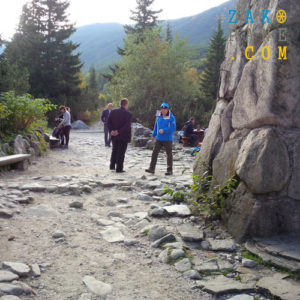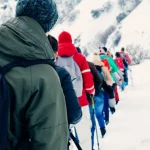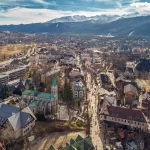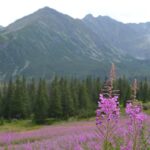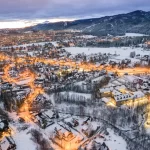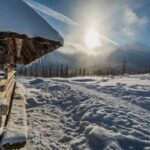Tatra Fashion Review
Tatra Fashion Review
Although the subject seems banal and dozens of texts have been written about how to dress in the mountains, it turns out that people’s fantasy has no limits. There will always be someone who can imagine flip-flops for the slogan “comfortable shoes”. Let us briefly discuss the subject once again, and what, apart from the clothes, really will be useful in the mountains.
Shoes are the basis
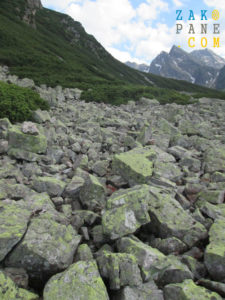
This is the route under the Zolta Turnia, theoretically easy. Well, probably we already know the answer to the question whether our trip will be comfortable and safe in the flip-flops.
There are many myths about shoes suitable for trips to the mountains. The most popular is “just above the ankle”. Yes and no. Of course, the high shoe stabilizes the ankle. Sometimes, however, it causes the injury of the Achilles tendon, when the back of the shoe squeezes or hits the place for many hours. If it is too laced, it can cause swelling of the legs, as well as extremely unpleasant stasis of blood in the veins. Sometimes it is just too warm in such a shoe. It is possible to try for ankle-high boots, or even trekking sandals, with only your heel and your fingers covered. Anyway, the most important is the sole. And here is another myth – “only vibram”. Not necessarily. Manufacturers are constantly coming up with new patents for non-slip plastics and protector forms that will keep us safe on slippery rock and before we buy shoes, ask the seller, read the reviews online and, above all, test them solidly in the store. In the best there is an artificial ramp for checking.
Sneakers are a very common choice. They do not have to be a bad idea if they have a good sole, but we should not choose them at Orla Perc. But, they are definitely better than flip-flops. The shoe cannot fall off the leg, if it orders us into the abyss, we can not leave the trail to get it back. It also has to protect our foot from hitting the stone, to protect against injury, when by accident the stick of a tourist walking nearby will be dangerously close. The abysmal idea is in turn tennis shoes on a thin sole without any protector. They not only threaten to slip, but also on the road lined with sharp stones we will feel pain and we will not get far.
Shoes – so socks also!
Or maybe not? On hot days, we can get tired with socks on our legs, especially thick ones. It is better to spend a lot of time choosing shoes perfectly suited to the size and shape of the foot, rather than catching up using the socks. Especially you need to be careful for the popular folding of high socks in rolls on ankles – the veins will not thank you, just like for tight binders. Generally, they are better made of synthetic fibers, draining water from the foot, and if we prefer natural fibers, then thin bamboo. You can try shoe insoles that absorb sweat and use them for shoes on the barefoot – washing them, or even throwing them out after a single trip will not be a problem.
Trousers
That pants are better than a skirt, it seems obvious. But not necessarily. On the trails, we meet numerous nuns who traverse the routes in long-to-the-ground habits and do well. However, in the higher parts of the mountains, this is not a safe solution. So pants. Which? There are many models of trekking trousers in stores, some of the numerous advantages, such as pockets, quick-drying material and neat cut, also have the option of detachable legs, so that shorts could be made of them. They also have a disadvantage – they mercilessly rustle at every step. After a few hours of wandering, we’ll give up everything to not hear this sound. That’s why knitwear-trousers are often chosen as well. Tight, as for jogging or loose sweatpants. Tight do not hook on rocks in demanding terrain, while on a sunny day it can be too warm in them, especially if they are black. Looser, preferably half-calf, knee-high – they will work everywhere. And it’s best that they’re made of quick-drying material.
T-shirt
A popular choice is a shirt made of breathable fabric with modern fibers. Equally frequent – cotton. The difference is that the artificial dries better and we’ll sweat for sure, but on the other hand, it acquires a very unpleasant smell over time. Cotton or viscose is nice to touch. A highly recommended solution is a tank-top shirt or with straps complete with a shawl to cover the shoulders from rubbing the straps with a backpack. From the bottom airflow, protection from above, also protects from the burning sun.
Fleece top
Necessary. Certainly there will be moments when the sun sets, we will be cold at a longer standstill, or the temperature will suddenly drop. Fleece, preferably full-length, is the best. In contrast to the cotton sweatshirt it is lightweight, which we will appreciate when carrying a backpack. And it will dry faster in the event of rain. It can also be a blouse from another modern fabric.
Jacket
It does not have to be thick. Down we leave for the winter. It has to protect against rain. And ideally, if it had a hood hidden in the collar, thin and airtight. Wind-stopper jackets are an excellent choice, wind can blow really hard in peak areas. What jacket will not work? Plastic, artificial leather, with quilted hood. And too tight, under which the fleece will not fit.
Headgear
Very important. A multifunctional scarf you can buy in a sports shop, a thin knit cap will work. Peak cap maybe is a little less practical because it does not provide sufficient ventilation in conditions of an effort and it does slightly reduces visibility. We leave the straw hats for the lowlands. Like shoes, we cannot “chase” them off the trail in the event of a loss, and the wind can make such a surprise.
Sunglasses
Necessary, even on a cloudy day. The amount of luxes at the level of 1.5-2 thousands meters is really big. It is best to have them hung on a string around the neck, inserting them behind the neckline of the shirt usually ends with a loss.
Gloves
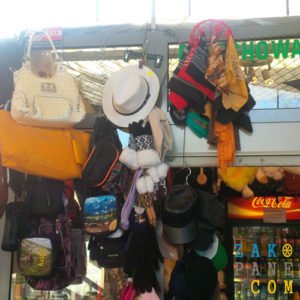
If we forget something, the stores do not have too wide offer. On the contrary street stalls – we will find there equipment for every season. Summer hats, cowboy bandanas, warm socks … It is worth to buy excellent gloves from a real sheepskin, they will come in handy during the winter in the city.
Non-slip wherever it is necessary to use your hands to climb -on chains, rocky sections. Some people cope with using thick horticultural working gloves with a rubberized inner side. Thin, but warm – on cool evenings, when your hands are suspended for many hours downward, the circulation stops somewhat and we will feel severe cold.
Backpack
It seems an obvious choice. However, there are people who risk not only loss of comfort but also security – and parade along the trail with the plastic shopping bag. In the valley, eventually, maybe it will not be convenient, but nothing will happen. But you can lose a life on Rysy without having both hands free. The backpack should have a hip and/or chest belt to better hold on to the body, especially in exposed, difficult terrain. It’s should be impregnated, and if we have doubts about its resistance to water, we should protect valuable things inside in thick foil bags. It should be large enough to store water bottle, first aid kit, spare clothes, food, map – capacity of 25 liters is the minimum.
Unfortunately, people are seen walking up empty-handed. No water, no food, just nothing, a smartphone in the pocket and that’s all. It may be worth mentioning that in the Tatras doesn’t operate service supplying food and water on-call, in the shelters they do not sell clothes, only raincoats, we will not get medicines, at most only tissues. If we feel uncomfortable washing our hands only with water, it is worth having a gel for hands, or wet disinfecting wipes, in shelters the staff sometimes does not keep up with filling up soap dispensers.
Capture this moment.
Most people are taking pictures in the mountains. Most often with a smartphone, but there are also lovers of solid reflex cameras. It is worth having a charged battery, a spare one or a power bank, there are no public docking stations and chargers in the shelters, although the individual free sockets may happen in the dining room or bathroom. Certainly not enough for everyone, and also not worth it spending a long time in the shelter waiting for the phone to be charged up. Of course, a full battery is important not only for photos, but also for safety if we have to call for help. It also works as a flashlight, if by accident we find ourselves on the trail after twilight. Although it is worth having separate one, most people use headlamps, but if for someone it is uncomfortable, hand-held can also be. Provided that we do not have to use hands to climb – but generally we should not be in the rocky parts after twilight. Coming back to the camera – even if we have it hanging around the neck, it’s good to have a space for it in the backpack. There are such episodes on the most difficult routes, where everything what can cumber and bump will be hindering us. And if it’s heavy, valuable equipment, it’s a shame to destroy it by hitting rocks with it. Of course, we do not have to give up taking pictures. Just find a stable place where we can open the backpack without fear of falling into the abyss, take out the camera and after the session, hide it back, securing in something soft. Similarly, let’s deal with the fashionable gadget, selfie stick.

In the Tatras, the dress code is not very restrictive. You can climb Rysy in an Mexican jacket or even without a T-shirt. And did you remember about the sunscreen cream?
Poles
Only ten or fifteen years ago in the mountains we could catch moments of absolute silence. Today it is impossible. From all sides reaches a sound of poles tapping on rocks. They spread along with Nordic Walking trend. Are they so needed? Honestly, opinions are divided. Of course, they can relieve the pain of joints slightly when going down steep grades. On the other hand, walking in the mountains is why it is such a great way to take care of the condition, because it involves muscles not only of the legs, but also of the whole torso and hands. Having poles, we do not give ourselves a chance to learn such body balancing, to maintain equilibrium, but also to control encumbrance of muscles and joints in a balanced way. Poles can also be very disturbing in the upper parts of the mountains, even those folded, if they stick out of the backpack, they can hook against something. However, they are not allowed to be carried in the hands where they are needed to catch chains and buckles, it is like asking for an accident. On the other hand, everywhere else, especially on trips on flat terrain, like valleys, poles can be useful, motivate to a bit more energetic march. For sure, if we take them with us, it is worth choosing a model with anti-shock shock absorption.
Cape
At the end few words about the most characteristic element of Tatra and Zakopane clothing. The cape works well in most cases of light drizzle, and walk in the valleys or not very high in the mountains. It does not work in the event of a heavy downpour – it will soak. And on Orla Perc, the risk of hooking the rocks is too great. Ultimately, rain is just water, if only we have the opportunity to dry out at home we should not get cold. Shoes can be dried with special dryers. We will find some in the old shelter on Morskie Oko. In other, named Murowaniec, a tumble-drier adapted to sports clothing awaits guests. If we go down to Zakopane, we will have a lot of possibilities to warm up. From the sauna to the tea with cherry vodka. Bearing in mind the first way – let’s take with us also a swimsuit. Not always you can buy it in a hotel, even if there is a swimming pool in the building.
Finally, it may be worth mentioning that all today’s guidelines and recommendations did not exist twenty years ago. The mountains were massively walked in jeans, heavy leather hiking boots or sneakers, the style was also flannel shirts, backpacks were often canvas, and instead of fleece were worn scratchy wool sweaters and even with such equipment peaks were also conquered. Many rescuers pay attention to the fact that today it is easy to have a false sense that we are well-equipped – and therefore safe. Meanwhile, no modern fabrics and technologies will suffice if we break the rules of behavior in the mountains, act carelessly or overly trust in gadgets. On the other hand, exaggeration is not good and really, at least chains we do not have to take our own (although there are those who declare such a desire;)). Successful trips!
Anna Markiewicz


